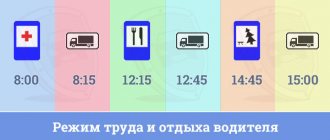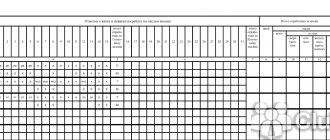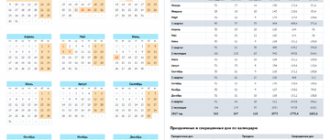Standard working hours for 2022
An important task for a HR specialist is to correctly determine the standard work time, because thanks to it, the workload and corresponding payments for work are established.
What are the working hours standards for 2022 (table below)? Employees and HR specialists are always concerned about the question of what duration of the labor process is considered normal.
Labor legislation states that 40 hours per week is the normal duration of work. Work and rest schedules in institutions are approved taking into account this figure. However, a schedule of 24 or 36 hours may be normal.
The monthly working hours for 2022 are determined based on the weekly one, and the number of hours worked by the employee may vary.
How to summarize working hours during a shift schedule: payment for holidays
So, in accordance with the laws of Russia, the process of increasing payment transactions also applies to persons going to work at a time not originally intended for this:
- hourly workers receive double pay;
- employees with a piece rate scheme can also qualify for double rates;
- Salaried specialists are faced, for example, with a single average daily salary given as an incentive.
These are the regulations that are spelled out in the Labor Code of the Russian Federation, and no entrepreneur can ignore them. As mentioned earlier, the fact of non-compliance with these sections of the law is a direct path to all sorts of problems that appear during the first inspection by the relevant inspectorate. You can save yourself from all sorts of discrepancies, including with the help of specialized commercial software, through which all calculations will be carried out. For example, the Russian company produces such software.
Production calendar in 2022
For an accountant and HR specialist, a production calendar becomes an assistant in their activities. It contains a large amount of information about holidays, weekends, and shortened days. The document, for example, indicates how many such days the corresponding period includes, what the work standard is for working weeks of different lengths (24, 36, 40 hours) in each half-year, quarter, month and year as a whole. From the document you can find out what dates certain professional holidays fall on.
The calendar helps the accountant correctly calculate wages, sick leave, vacation pay, and determine work schedules. This document will help the employee choose the appropriate period for vacation.
In 2020, the calendar shows the following important events:
1. Weekends have been postponed
- from Saturday 05.01 to Thursday 02.05;
- from Sunday 06.01 to Friday 03.05
- from Saturday 23.02 to Friday 10.05.
2. Holidays are days off
- from 01.01 to 08.01 - New Year holidays;
- 07.01 - Christmas;
- 23.02 — Defender of the Fatherland Day;
- 08.03 — International Women's Day;
- 01.05 — Spring and Labor Day;
- 09.05 — Victory Day;
- 12.06 — Russia Day;
- 04.11 — Day of National Unity.
3. Abbreviated days are:
- 22.02;
- 07.03;
- 30.04;
- 08.05
- 11.06;
- 31.12.
RMS by periods
The payment of guards and the general rules of wages when recording working hours are summarized is an issue that sooner or later arises within the framework of any large business. That is why organizations that are faced with the problem of scheduling for the first time can rely on the experience of other companies. In modern Russian realities, almost all major brands use a methodology for conducting salary transactions that is based on a certain frequency. The specialist responsible for debugging the work regime simply introduces the concept of some interval after which the master will receive the money due to him. This resolution is enshrined both in the TD and in local acts of the corporation.
How to calculate labor standards
In determining the normal duration of work, the order of the Ministry of Health dated August 13, 2009 No. 588n plays a decisive role.
The duration of work during the week, established for the employee, determines the norm for him. The basis is a calculation schedule containing five working days and two days of rest, as well as the duration of the working day or shift.
In the case where an employee has a work week of 40 hours, the duration of work per day is 8 hours; with a 36-hour week - 7.2 hours; at 24 hours - 4.8 hours. Existing work and rest regimes are determined by these figures.
On the eve of the holiday, the duration of work is reduced by one hour (Part 1 of Article 95 of the Labor Code of the Russian Federation). In 2020, such days fall on the following dates: 02/22, 03/07, 04/30, 05/08, 06/11, 12/31. If the Government approves the transfer of a day off to a working day, the duration of work is similar to the duration of the working day to which the day off is transferred. Thus, work on the specified dates will be shorter.
For example, let’s compare two months and see what the working hours are in April 2022 and what the working hours are in March 2020.
Calculation example
In April there are 22 working days and 8 days off (calculated as a work week of five working days and two days off).
The normal period (taking into account one day shortened by 1 hour) is:
- with a work week of 40 hours - 175 hours (8 hours x 22 days - 1 hour);
- at 36 hours - 157.4 (7.2 x 22 - 1);
- at 24 hours - 104.6 (4.8 x 22 - 1).
In March there are 20 working days and 11 days off.
The norm for the period will be (also with one shortened day):
- with a work week of 40 hours - 159 hours (8 x 20 - 1 hour);
- at 36 hours - 143 (7.2 x 20 - 1 hour);
- at 24 hours -95 (4.8 x 20 - 1 hour).
What is working time balance?
The working period within a certain calendar period minus weekends and regularly scheduled vacations is considered to be the balance of working time. It is distributed on average across all structural divisions of the organization and is determined in the form of working days and hours required to be worked by each employee in the planning period.
The working time balance consists of several funds:
- calendar: determined for a specific calendar period, taking into account working and non-working time;
- nominal: takes into account working hours, non-working periods and absence on sick leave;
- effective: consists of a working time fund, taking into account all non-working days;
- useful: determined by calculating the average productivity of a working day and multiplying this value by the number of working days minus vacation days and sick leave.
Non-working days are considered to be planned weekends and holidays established by the state and reflected in the production calendar.
The balance is compiled in the following units:
- man-days;
- man hours.
The latter unit is accepted as more accurate; it is the one that is most often used when calculating the components of the balance sheet. Working hours are divided into three sections:
- Work time in production is man-hours actually worked.
- Time of absence for valid reasons.
- Lost working time.
When compiling the balance, hours worked overtime are also taken into account. This is a convenient tool for comparing working hours over several periods. Then you can draw conclusions about its savings or overexpenditure.
The use of the working time fund can be determined by the following indicators:
- the average number of employees of the organization as a whole, as well as for each structural unit;
- time worked by all employees;
- the number of man-days worked in total;
- number of days and average time worked by one employee;
- average working day;
- time worked overtime.
Based on the working time balance, you can analyze the work of the organization as a whole and find ways to increase productivity. To do this, it is necessary to display the time that was spent on non-production issues associated with downtime for any reason. For example, the lack of raw materials for production, disruption of the technological process, the cost of labor time to eliminate defects, absenteeism, etc.
Every year, to help HR officers and accountants, a production calendar is drawn up, which takes into account:
- work days;
- weekend;
- standard working hours.
For ease of use, it contains information broken down quarterly and monthly for different numbers of working hours per week used in organizations of any field of activity. The use of a production calendar in accounting allows the payroll clerk to accurately calculate wages, pay sick leave, calculate vacation pay, etc.
Working hours standards
The work schedule (five or six days) affects the established work norm.
With a five day week
With five working days, the quarterly norms and number of days are as follows:
| 2020 | Amount of days | Length of labor time (hours) | ||||
| Calendar | Workers | Weekends and holidays | 40 hours/week | 36 hours/week | 24 hours/week | |
| I quarter | 90 | 57 | 33 | 454 | 408.4 | 271.6 |
| II quarter | 91 | 59 | 32 | 469 | 421.8 | 280.2 |
| III quarter | 92 | 66 | 26 | 528 | 475.2 | 316.8 |
| IV quarter | 92 | 65 | 27 | 519 | 467 | 311 |
| YEAR | 365 | 247 | 118 | 1970 | 1772,4 | 1179,6 |
In 2022, during the five-day period, there are the following long periods of rest:
- from 12/30/2018 to 01/08/2019 inclusive (New Year holidays);
- from 08.03 to 10.03 (International Women's Day);
- from 01.05 to 05.05 (Spring and Labor Holiday);
- from 09.05 to 12.05 (Victory Day)
- from 02.11 to 04.11 (National Unity Day).
With a six day week
With six working days, the quarterly norms and number of days are as follows:
| 2020 | Amount of days | Length of labor time (hours) | ||||
| Calendar | Workers | Weekends and holidays | 40 hours/week | 36 hours/week | 24 hours/week | |
| I quarter | 90 | 68 | 22 | 454 | 408,4 | 271,6 |
| II quarter | 91 | 74 | 17 | 469 | 421,8 | 280,2 |
| III quarter | 92 | 79 | 13 | 528 | 475,2 | 316,8 |
| IV quarter | 92 | 78 | 14 | 519 | 467 | 311 |
| YEAR | 365 | 299 | 66 | 1970 | 1772,4 | 1179,6 |
Calendar for postponing holidays in 2022
Decree of the Government of the Russian Federation dated September 16, 2021 N 1564 provides for the following replacement of days off in 2022:
- from January 1 (Saturday) to May 3 (Tuesday);
- from January 2 (Sunday) to May 10 (Tuesday);
- from March 5 (Saturday) to March 7 (Monday).
Thus, due to the postponement of holidays in 2022, Russians are expected to traditionally have a long weekend for the New Year. They will last 10 days - from December 31, 2022 to January 10, 2022.
The next period of long rest falls in March - from March 6 to March 8.
Traditionally, May will be generous for holidays and long vacations. In May 2022, Russians will have a holiday from May 1 to 3 in connection with the Spring and Labor Festival, as well as from May 7 to 10 in connection with Victory Day.
In November, in connection with the celebration of National Unity Day, the weekend will last from November 4 to November 6, 2022.
Work standards for 2022 as a whole
In 2022 - 247 days of work (including 6 shortened by one hour) and 118 days off and non-working holidays (subject to working a work week, including five working days and two days off).
The total working time is:
- with a 40-hour work week - 1970 hours:
(8 x 247 days - 6 hours = 1,970);
- with a 36-hour work week - 1772.4 hours:
(7.2 x 247 days - 6 hours = 1,772.4);
- with a 24-hour work week - 1179.6 hours:
(4.8 x 247 days - 6 hours = 1,179.6).
Forms and means of recording working hours
Time tracking is a recording of the hours that an employee actually devoted to his work duties. To implement accounting, timesheets are usually used. The accounting sheet in form T-12 is filled out manually. A special employee is appointed to conduct it.
The report card in form T-13 is compiled using an automatic program for recording accounting indicators.
The report card records daily the attendance of employees, the specifics of work (day, night, overtime, work on weekends and holidays), the number of vacation days, and the employee’s absence (indicating the reason).
When recording working hours in aggregate, the employer must draw up a work schedule. This responsibility is not directly assigned to the employer, but such a schedule will help to keep accurate records of working hours and prevent accidental overtime. In fact, the work schedule indicates the expected work time of each employee (start, end, number of hours).
Of course, the work schedule is to some extent compensated for and duplicated by a time sheet. But their main difference is that the work schedule is drawn up as a plan for the future workload of employees, and the information in the time sheet is indicated based on the fact of work.
Numerous additional tools are also used to facilitate time tracking. These include:
- employee arrival and departure logs;
- special access devices using biometric identification systems, magnetic plastic cards, combination locks;
- means of tracking the entry and exit of people into/out of the enterprise territory (video cameras, alarms). Such devices are used not only for recording working hours, but also for safety. They are established openly with the consent of the organization's employees ;
- tools for monitoring work on a computer, preventing unproductive waste of working time, recording labor costs for completing individual tasks (DLP systems and time trackers), etc.
How to calculate the norm for summarized accounting
Cumulative accounting is a labor regime of a special nature, which is based on established schedules.
The payment option for work is determined by the employer. It can be:
- hourly rate (calculated based on the number of hours worked in a particular month);
- official salary (fixed amounts paid every month).
When installing summarized accounting, you should select the optimal accounting period: month, quarter or year. In this situation, the employer chooses. A period exceeding one year is not provided.
When introducing summarized accounting, the following must be observed:
- The regime is being implemented in those institutions where it is not possible to establish compliance with working hours on an ongoing basis.
- The amount of work time for a specified period cannot exceed the standards provided for by law.
- Compliance with the schedule is mandatory.
- The duration of overtime work is calculated at the end of the accounting period.
Payment order
It is not difficult to guess that within companies using RMS systems, the employer chooses the method of calculating wages independently based on his own preferences, as well as the characteristics of individual and general TD. The method of executing transactions for actual processing is used as often as possible. Particularly popular are both ordinary tariff rates and salaries presented in the form of fixed amounts and values.
Understanding what an accounting period is when recording working hours in total is the real key to organizing a competent process for the functioning of the company. However, the person implementing the presented regime must definitely sort out the payment. In certain situations, the employer should opt for a piece-rate scheme, according to which remuneration is calculated depending on the number of units, for example, of goods produced. Such regulations have already been regularly tested at enterprises, say, in the factory or sewing format. They are an excellent incentive for professional craftsmen who want to see the direct results of their operations.
Payment for night work
Each hour of work at night (from 22.00 to 6.00) is paid at an increased rate compared to work in normal conditions, but not lower than the amounts established by labor legislation (Part 1 of Article 154 of the Labor Code of the Russian Federation) regardless of the remuneration system and type working time recording.
The minimum increase in wages for night work is established by law and is 20 percent of the hourly tariff rate (salary calculated per hour of work) for each hour of night work.
To reflect the hours worked at night in the time sheet, use the letter code “H” or the numeric “02” indicating the number of hours worked at night.
Annual time norm for five-day and six-day periods
To determine the annual standard of working time, we use the formula:
Where
- НРВг - annual standard working time;
- NRVn - weekly standard working time;
- RDn - number of workdays in a week (5 or 6);
- RDg - annual number of working days.
The total number of working hours per year for both a five-day and a six-day workweek is the same, and in 2022 with a forty-hour week will be 1973 hours. It’s just that the length of the working day (shift) for those who work 6 days a week is shorter than for those who work 5 days.
Time standards for certain categories of workers
The Labor Code establishes a shortened working week for certain categories of personnel:
- workers under 16 years of age - 24 hours;
- workers aged 16–17 years, disabled people of groups I and II – 35 hours;
- working in hazardous and hazardous areas - 36 hours.
To determine how much such people should work daily, divide the weekly time allowance by the number of working days. So, for example, for disabled people during a five-day workday, the daily output will be 7 hours.
Normal working hours
First of all, let's define the concept of working time. So, working time is the period when an employee is obliged to fulfill his duties as provided for in the agreement between him and the employer.
Note that this concept includes not only the time of direct performance of the labor function, but also other periods. For example, this includes a break for feeding a child, a period of eating at the place of direct work, special breaks for heating and rest, and some other work breaks. Without exceptions, the normal working hours according to the Labor Code are 40 hours per week.
However, it is worth saying that for some categories of workers reduced working hours are provided.










